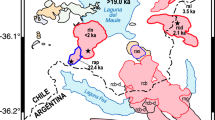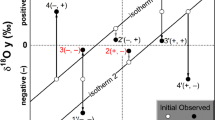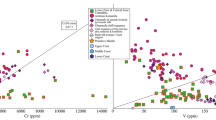Abstract
Calculations of the energetics of terrestrial accretion indicate that the Earth was extensively molten in its early history1. Examination of early Archaean rocks from West Greenland (3.6–3.8 Gyr old) using short-lived 146Sm–142Nd chronometry indicates that an episode of mantle differentiation took place close to the end of accretion (4.46 ± 0.11 Gyr ago)2,3,4. This has produced a chemically depleted mantle with an Sm/Nd ratio higher than the chondritic value. In contrast, application of 176Lu–176Hf systematics to 3.6–3.8-Gyr-old zircons from West Greenland indicates derivation from a mantle source with a chondritic Lu/Hf ratio5,6,7. Although an early Sm/Nd fractionation could be explained by basaltic crust formation8, magma ocean crystallization2 or formation of continental crust, the absence of coeval Lu/Hf fractionation is in sharp contrast with the well-known covariant behaviour of Sm/Nd and Lu/Hf ratios in crustal formation processes5. Here we show using mineral–melt partitioning data for high-pressure mantle minerals that the observed Nd and Hf signatures could have been produced by segregation of melt from a crystallizing magma ocean at upper-mantle pressures early in Earth's history. This residual melt would have risen buoyantly and ultimately formed the earliest terrestrial protocrust.



Similar content being viewed by others
References
Tonks, B. T. & Melosh, H. J. Magma ocean formation due to giant impacts. J. Geophys. Res. 98, 5319–5333 (1993)
Caro, G., Bourdon, B., Birck, J.-L. & Moorbath, S. 146Sm-142Nd evidence from Isua metamorphosed sediments for early differentiation of the Earth's mantle. Nature 423, 428–432 (2003)
Caro, G., Bourdon, B., Birck, J.-L. & Moorbath, S. High-precision 142Nd/144Nd measurements in terrestrial rocks: constraints on the early differentiation of the Earth's mantle. Geochim. Cosmochim. Acta (submitted)
Harper, C. L. & Jacobsen, S. B. Evidence from coupled 147Sm-143Nd and 146Sm-142Nd systematics for very early (4.5-Gyr) differentiation of the Earth's mantle. Nature 360, 728–732 (1992)
Vervoort, J. D. & Blichert-Toft, J. Evolution of the depleted mantle: Hf isotope evidence from juvenile rocks through time. Geochim. Cosmochim. Acta 63, 533–556 (1999)
Amelin, Y., Lee, D.-C. & Halliday, A. N. Early-middle Archaean crustal evolution deduced from Lu-Hf and U-Pb isotopic studies of single zircon grains. Geochim. Cosmochim. Acta 64, 4205–4225 (2000)
Scherer, E., Münker, C. & Mezger, K. Calibration of the lutetium-hafnium clock. Science 293, 683–686 (2001)
Chase, C. G. & Patchett, P. J. Stored mafic/ultramafic crust and early Archean mantle depletion. Earth Planet. Sci. Lett. 91, 66–72 (1988)
Corgne, A. & Wood, B. J. Trace element partitioning between majoritic garnet and silicate melt at 25 GPa. Phys. Earth Planet. Inter 143–144, 407–419 (2004)
Corgne, A., Liebske, C., Wood, B. J., Rubie, D. C. & Frost, D. J. Silicate perovskite-melt partitioning of trace elements and geochemical signature of a deep perovskitic reservoir. Geochim. Cosmochim. Acta 69, 485–496 (2005)
Walter, M. J., Nakamura, E., Trønnes, R. G. & Frost, D. J. Experimental constraints on crystallization differentiation in a deep magma ocean. Geochim. Cosmochim. Acta 68, 4267–4284 (2004)
Bizzarro, M., Baker, J. A., Haack, H., Ulbeck, D. & Rosing, M. G. Early history of Earth's crust-mantle system inferred from hafnium isotopes in chondrites. Nature 421, 931–933 (2003)
Patchett, P. J., Vervoort, J. D., Söderlund, U. & Salters, V. J. M. Lu-Hf and Sm-Nd isotopic systematics in chondrites and their constraints on the Lu-Hf properties of the Earth. Earth Planet. Sci. Lett. 222, 29–41 (2004)
Söderlund, U., Patchett, P. J., Vervoort, J. D. & Isachsen, C. E. The 176Lu decay constant determined by Lu-Hf and U-Pb isotope systematics of Precambrian mafic intrusions. Earth Planet. Sci. Lett. 219, 311–324 (2004)
Blichert-Toft, J. & Albarède, F. The Lu-Hf isotope geochemistry of chondrites and the evolution of the mantle-crust system. Earth Planet. Sci. Lett. 148, 243–258 (1997)
Solomatov, V. S. & Stevenson, D. J. Nonfractional crystallization of a terrestrial magma ocean. J. Geophys. Res. 98, 5391–5406 (1993)
Abe, T. Thermal and chemical evolution of the terrestrial magma ocean. Phys. Earth Planet. Inter. 100, 27–39 (1997)
Kato, T., Ringwood, A. E. & Irifune, T. Experimental determination of element partitioning between silicate perovskites, garnets and liquids: constraints on early differentiation of the mantle. Earth Planet. Sci. Lett. 89, 123–145 (1988)
Ringwood, A. E. Phase transformations and the constitution of the mantle. Phys. Earth Planet. Inter. 3, 109–155 (1970)
Hirose, K. Phase transitions in pyrolitic mantle around 670-km depth: Implications for upwelling of plumes from the lower mantle. J. Geophys. Res. 107(B4), 2078, doi:10.1029/2001JB000597 (2002)
Wood, B. J. Phase transformations and partitioning relations in peridotite under lower mantle conditions. Earth Planet. Sci. Lett. 174, 341–354 (2000)
Kesson, S. E., Fitz Gerald, J. D. & Shelley, J. M. Mineralogy and dynamics of a pyrolite lower mantle. Nature 393, 252–255 (1998)
Salters, V. & Longhi, J. Trace element partitioning during the initial stages of melting beneath mid-ocean ridges. Earth Planet. Sci. Lett. 166, 15–30 (1999)
Draper, D. S., Xirouchakis, D. & Agee, C. B. Trace element partitioning between garnet and chondritic melt from 5 to 9 GPa: implications for the onset of the majorite transition in the martian mantle. Phys. Earth Planet. Inter. 139, 149–169 (2003)
Ito, E., Kubo, A., Katsura, T. & Walter, M. J. Melting experiments of mantle materials under lower mantle conditions with implications for magma ocean differentiation. Phys. Earth Planet. Inter. 143–144, 397–406 (2004)
Zhang, J. & Herzberg, C. Melting experiments on anhydrous peridotite KLB-1 from 5.0 to 22.5 GPa. J. Geophys. Res. 99(B9), 17729–17742 (1994)
Trønnes, R. G. & Frost, D. J. Peridotite melting and mineral-melt partitioning of major and minor elements at 22–24.5 GPa. Earth Planet. Sci. Lett. 197, 117–131 (2002)
Corgne, A. & Wood, B. J. Trace element partitioning and substitution mechanisms in calcium perovskites. Contrib. Mineral. Petrol. 149, 85–97, doi:10.1007/s00410–004–0638–3 (2005)
Salters, V. J. M. & Stracke, A. Composition of the depleted mantle. Geochem. Geophys. Geosyst. 5, Q05004, doi:10.1029/2003GC000597 (2004)
Acknowledgements
We thank F. G. S. Labrosse, J. Blichert-Toft and A. Halliday for discussions. Comments and suggestions by M. Rekhämper and J. Vervoort greatly improved the manuscript. This study was partly supported by the CNRS research programmes IT and PNP.
Author information
Authors and Affiliations
Corresponding author
Ethics declarations
Competing interests
Reprints and permissions information is available at npg.nature.com/reprintsandpermissions. The authors declare no competing financial interests.
Supplementary information
Supplementary Figure S1
Estimating the Lu/Hf ratio of hadean depleted mantle using Hf isotope data in Amîtsoq zircons (West Greenland, 3.6 - 3.8 Gyr). (PDF 83 kb)
Supplementary Table S1
Compilation of Lu-Hf data for Jack Hills (Australia) and Amîtsoq (West Greenland) zircons. (PDF 45 kb)
Supplementary Table S2
Crystal/melt partition coefficients for Lu, Hf, Sm and Nd used in fractional and equilibrium crystallization models. (PDF 40 kb)
Supplementary Equations
Equations applied in the modeling of Lu/Hf and Sm/Nd fractionation during magma ocean crystallization. (PDF 461 kb)
Rights and permissions
About this article
Cite this article
Caro, G., Bourdon, B., Wood, B. et al. Trace-element fractionation in Hadean mantle generated by melt segregation from a magma ocean. Nature 436, 246–249 (2005). https://doi.org/10.1038/nature03827
Received:
Accepted:
Issue Date:
DOI: https://doi.org/10.1038/nature03827
- Springer Nature Limited
This article is cited by
-
Direct evidence for crust-mantle differentiation in the late Hadean
Communications Earth & Environment (2022)
-
Hadean silicate differentiation preserved by anomalous 142Nd/144Nd ratios in the Réunion hotspot source
Nature (2018)
-
Connections between the bulk composition, geodynamics and habitability of Earth
Nature Geoscience (2015)
-
The tungsten isotopic composition of the Earth’s mantle before the terminal bombardment
Nature (2011)
-
Super-chondritic Sm/Nd ratios in Mars, the Earth and the Moon
Nature (2008)





